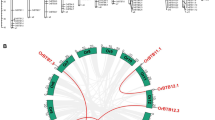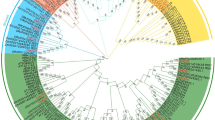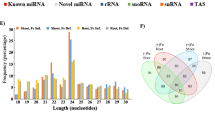Abstract
Main conclusion
The MIR gene is not an Oryza sativa orphan gene, but an Oryza genus-specific gene that evolved before AA lineage speciation by a complex origination process.
Abstract
Rice (Oryza sativa L.) is a model species and an economically relevant crop. The Oryza genus comprises 25 species, with genomic data available for several Oryza species, making it a model for genetics and evolution. The Mitochondrial Iron-Regulated (MIR) gene was previously implicated in the O. sativa Fe deficiency response, and was considered an orphan gene present only in rice. Here we show that MIR is also found in other Oryza species that belong to the Oryza sativa complex, which have AA genome type and constitute the primary gene pool for O. sativa breeding. Our data suggest that MIR originated in a stepwise process, in which sequences derived from an exon fragment of the raffinose synthase gene were pseudogenized into non-coding, which in turn originated the MIR gene de novo. All species with a putative functional MIR gene conserve their regulation by Fe deficiency, with the exception of Oryza barthii. In O. barthii, the MIR coding sequence was translocated to a different chromosomal position and separated from its regulatory region, leading to a lack of Fe deficiency responsiveness. Moreover, the MIR co-expression subnetwork cluster in O. sativa is responsive to Fe deficiency, evidencing the importance of the newly originated gene in Fe uptake. This work establishes that MIR is not an orphan gene as previously proposed, but a de novo originated gene within the genus Oryza. We also showed that MIR is undergoing genomic changes in one species (O. barthii), with an impact on Fe deficiency response.









source of the non-conding sequence present in chromosome 6 of almost all Oryza sativa complex, AA genome species. This event may have happened before Oryza sativa complex last common ancestor divergence, but seems to be lost to all but Oryza sativa complex species within Oryza (except O. meridionalis—which diverged earlier than O. glumaepatula—and O. longistaminata—which diverged later than O. glumaepatula). Given that O. glumaepatula has the regions where the non-coding sequence from chromosome 4 and chromosome 6 are found, but has only the chromosome 6 sequence, we suggest that the chromosome 6 was generated first, and was the source of MIR de novo origination—an event that occurred after O. glumeapatula speciation. After MIR origination, the sequence in chromosome 6 was also duplicated to generate the non-coding sequence in chromosome 4. The change in the chromosomal position of ObarMIR and the separation of its regulatory sequence is shown. It should be noted that the raffinose synthase gene also underwent duplication during the evolution of the monocot lineage. Coding exons are shown as rectangles; the MIR exon and the exon that originated the chromosome 6 non-coding region is shown in red, whereas other exons of raffinose synthase gene are shown in blue. Non-coding sequences originated from raffinose synthase exon are shown as white rectangles. The promoter region of MIR is shown as a thick line. Duplication events are highlighted by a yellow star
Similar content being viewed by others
Abbreviations
- MIR :
-
Mitochondrial Iron Regulated
- IDE1:
-
Iron deficiency element1
- IDEF1:
-
Iron deficiency element-binding factor1
- –Fe:
-
Fe deficiency
- MYA:
-
Million years ago
References
Alexa A, Rahnenführer J (2019) Gene set enrichment analysis with topGO. In: https://www.mpi-sb.mpg.de/∼alexa
Altschul SF, Gish W, Miller W et al (1990) Basic local alignment search tool. J Mol Biol 215:403–410. https://doi.org/10.1016/S0022-2836(05)80360-2
Arendsee ZW, Li L, Wurtele ES (2014) Coming of age: Orphan genes in plants. Trends Plant Sci 19:698–708. https://doi.org/10.1016/j.tplants.2014.07.003
Barrett T, Wilhite SE, Ledoux P et al (2013) NCBI GEO: archive for functional genomics data sets—update. Nucleic Acids Res 41:991–995. https://doi.org/10.1093/nar/gks1193
Bashir K, Hanada K, Shimizu M et al (2014) Transcriptomic analysis of rice in response to iron deficiency and excess. Rice 7:18. https://doi.org/10.1186/s12284-014-0018-1
Bashir K, Ishimaru Y, Itai RN et al (2015) Iron deficiency regulated OsOPT7 is essential for iron homeostasis in rice. Plant Mol Biol 88:165–176. https://doi.org/10.1007/s11103-015-0315-0
Bashir K, Ishimaru Y, Shimo H et al (2011) The rice mitochondrial iron transporter is essential for plant growth. Nat Commun 2:322–327. https://doi.org/10.1038/ncomms1326
Callaway E (2014) The birth of rice. Nature 514:S58–S59
Castaings L, Caquot A, Loubet S, Curie C (2016) The high-affinity metal transporters NRAMP1 and IRT1 team up to take up iron under sufficient metal provision. Sci Rep 6:1–11. https://doi.org/10.1038/srep37222
Castro MAA, Wang X, Fletcher MNC et al (2012) RedeR: R/Bioconductor package for representing modular structures, nested networks and multiple levels of hierarchical associations. Genome Biol 13:R29. https://doi.org/10.1186/gb-2012-13-4-r29
Csardi G, Nepusz T (2006) The igraph software package for complex network research. Inter J Complex Syst Complex Sy:1695
Dobin A, Davis CA, Schlesinger F et al (2013) STAR: Ultrafast universal RNA-seq aligner. Bioinformatics 29:15–21. https://doi.org/10.1093/bioinformatics/bts635
Drummond AJ, Rambaut A (2007) BEAST: Bayesian evolutionary analysis by sampling trees. BMC Evol Biol 7:79–96. https://doi.org/10.1017/CBO9781139095112.007
Eddy SR (1998) Profile hidden Markov models. Bioinformatics 14:755–763
Edgar RC (2004) MUSCLE: multiple sequence alignment with high accuracy and high throughput. Nucleic Acids Res 32:1792–1797. https://doi.org/10.1093/nar/gkh340
Eide D, Broderius M, Fett JP, Lou GM (1996) A novel iron-regulated metal transporter from plants identified by functional expression in yeast. Proc Natl Acad Sci USA 93:5624–5628. https://doi.org/10.1073/pnas.93.11.5624
Elnitski L, Riemer C, Burhans R, et al (2005) MultiPipMaker: comparative alignment server for multiple DNA sequences. Curr Protoc Bioinform 10.4.1–10.4.12
Fruchterman TMJ, Reingold EM (1991) Graph drawing by force-directed placement. Softw Pract Exp 21:1129–1164
Gale MD, Devos KM (1998) Comparative genetics in the grasses. Proc Natl Acad Sci USA 95:1971–1974
Goodstein DM, Shu S, Howson R et al (2012) Phytozome: a comparative platform for green plant genomics. Nucleic Acids Res 40:D1178–D1186. https://doi.org/10.1093/nar/gkr944
Gu Z, Gu L, Eils R et al (2014) Circlize implements and enhances circular visualization in R. Bioinformatics 30:2811–2812. https://doi.org/10.1093/bioinformatics/btu393
Harris RS (2007) Improved pairwise alignmnet of genomic DNA. Dissertation. The Pennsylvania State University, Pennsylvania
Husnik F, McCutcheon JP (2018) Functional horizontal gene transfer from bacteria to eukaryotes. Nat Rev Microbiol 16:67–79. https://doi.org/10.1038/nrmicro.2017.137
Inoue H, Kobayashi T, Nozoye T et al (2009) Rice OsYSL15 is an iron-regulated iron(III)-deoxymugineic acid transporter expressed in the roots and is essential for iron uptake in early growth of the seedlings. J Biol Chem 284:3470–3479. https://doi.org/10.1074/jbc.M806042200
Ishimaru Y, Bashir K, Fujimoto M et al (2009) Rice-specific mitochondrial iron-regulated gene (MIR) plays an important role in iron homeostasis. Mol Plant 2:1059–1066. https://doi.org/10.1093/mp/ssp051
Jeong H, Tombor B, Albert R et al (2000) The large-scale organization of metabolic networks. Nature 407:651–654
Kobayashi T, Nishizawa NK (2012) Iron uptake, translocation, and regulation in higher plants. Annu Rev Plant Biol 63:131–152. https://doi.org/10.1146/annurev-arplant-042811-105522
Kobayashi T, Ogo Y, Itai RN et al (2007) The transcription factor IDEF1 regulates the response to and tolerance of iron deficiency in plants. Proc Natl Acad Sci USA 104:19150–19155. https://doi.org/10.1073/pnas.0707010104
Lawrence M, Huber W, Pagès H et al (2013) Software for computing and annotating genomic ranges. PLoS Comput Biol 9(8):e1003118. https://doi.org/10.1371/journal.pcbi.1003118
Lee S, Chiecko JC, Kim SA et al (2009) Disruption of OsYSL15 leads to iron inefficiency in rice plants. Plant Physiol 150:786–800. https://doi.org/10.1104/pp.109.135418
Li G, Jain R, Chern M et al (2017) The sequences of 1504 mutants in the model rice variety Kitaake facilitate rapid functional genomic studies. Plant Cell 29:1218–1231. https://doi.org/10.1105/tpc.17.00154
Li L, Foster CM, Gan Q et al (2009) Identification of the novel protein QQS as a component of the starch metabolic network in Arabidopsis leaves. Plant J 58:485–498. https://doi.org/10.1111/j.1365-313X.2009.03793.x
Li L, Wurtele ES (2015) The QQS orphan gene of Arabidopsis modulates carbon and nitrogen allocation in soybean. Plant Biotechnol J 13:177–187. https://doi.org/10.1111/pbi.12238
Livak KJ, Schmittgen TD (2001) Analysis of relative gene expression data using real-time quantitative PCR and the 2-ΔΔCT method. Methods 25:402–408. https://doi.org/10.1006/meth.2001.1262
Love MI, Huber W, Anders S (2014) Moderated estimation of fold change and dispersion for RNA-seq data with DESeq2. Genome Biol 15:550. https://doi.org/10.1186/s13059-014-0550-8
Menguer PK, Sperotto RA, Ricachenevsky FK (2017) A walk on the wild side: Oryza species as source for rice abiotic stress tolerance. Genet Mol Biol 40:238–252. https://doi.org/10.1590/1678-4685-gmb-2016-0093
Nozoye T, Nagasaka S, Kobayashi T et al (2011) Phytosiderophore efflux transporters are crucial for iron acquisition in graminaceous plants. J Biol Chem 286:5446–5454. https://doi.org/10.1074/jbc.M110.180026
Ogo Y, Itai RN, Nakanishi H et al (2006) Isolation and characterization of IRO2, a novel iron-regulated bHLH transcription factor in graminaceous plants. J Exp Bot 57:2867–2878. https://doi.org/10.1093/jxb/erl054
Ogo Y, Nakanishi Itai R, Nakanishi H et al (2007) The rice bHLH protein OsIRO2 is an essential regulator of the genes involved in Fe uptake under Fe-deficient conditions. Plant J 51:366–377. https://doi.org/10.1111/j.1365-313X.2007.03149.x
Pagès H, Aboyoun P, Gentleman R, DebRoy S (2019) Biostrings: Efficient manipulation of biological strings. R package version 2.52.0
Paradis E, Schliep K (2019) ape 5.0: an environment for modern phylogenetics and evolutionary analyses in R. Bioinformatics 35:526–528. https://doi.org/10.1093/bioinformatics/bty633
Pearson WR (2013) An introduction to sequence similarity (“homology”) searching. In: Current Protocols in Bioinformatics 42: 3.1.1–3.1.8
Posada D (2008) jModelTest: Phylogenetic model averaging. Mol Biol Evol 25:1253–1256. https://doi.org/10.1093/molbev/msn083
Ramakers C, Ruijter JM, Lekanne Deprez RH, Moorman AFM (2003) Assumption-free analysis of quantitative real-time polymerase chain reaction (PCR) data. Neurosci Lett 339:62–66. https://doi.org/10.1016/S0304-3940(02)01423-4
Rambaut A, Drummond AJ, Xie D et al (2018) Posterior summarization in Bayesian phylogenetics using Tracer 1.7. Syst Biol 67:901–904. https://doi.org/10.1093/sysbio/syy032
Reuscher S, Furuta T, Bessho-Uehara K et al (2018) Assembling the genome of the African wild rice Oryza longistaminata by exploiting synteny in closely related Oryza species. Commun Biol 1:162. https://doi.org/10.1038/s42003-018-0171-y
Revell LJ (2012) Phytools: an R package for phylogenetic comparative biology (and other things). Methods Ecol Evol 3:217–223. https://doi.org/10.1111/j.2041-210X.2011.00169.x
Ricachenevsky FK, Sperotto RA (2014) There and back again, or always there? The evolution of rice combined strategy for Fe uptake. Front Plant Sci 5:189. https://doi.org/10.3389/fpls.2014.00189
Ricachenevsky FK, Sperotto RA, Menguer PK et al (2011) Zinc-induced facilitator-like family in plants: lineage-specific expansion in monocotyledons and conserved genomic and expression features among rice (Oryza sativa) paralogs. BMC Plant Biol 11:1–22. https://doi.org/10.1186/1471-2229-11-20
Schlötterer C (2015) Genes from scratch – the evolutionary fate of de novo genes. Trends Genet 31:215–219. https://doi.org/10.1016/j.tig.2015.02.007
Schultz J, Copley RR, Doerks T et al (2000) SMART : a web-based tool for the study of genetically mobile domains. Nucleic Acids Res 28:231–234
Senoura T, Sakashita E, Kobayashi T et al (2017) The iron-chelate transporter OsYSL9 plays a role in iron distribution in developing rice grains. Plant Mol Biol 95:375–387. https://doi.org/10.1007/s11103-017-0656-y
Sperotto RA, Ricachenevsky FK, de Waldow Fett VAJP (2012) Iron biofortification in rice: it’s a long way to the top. Plant Sci 190:24–39. https://doi.org/10.1016/j.plantsci.2012.03.004
Stein JC, Yu Y, Copetti D et al (2018) Genomes of 13 domesticated and wild rice relatives highlight genetic conservation, turnover and innovation across the genus Oryza. Nat Genet 50:285–296. https://doi.org/10.1038/s41588-018-0040-0
Stein RJ, Duarte GL, Scheunemann L et al (2019) Genotype variation in rice (Oryza sativa L.) tolerance to Fe toxicity might be linked to root cell wall lignification. Front Plant Sci 10:746. https://doi.org/10.3389/fpls.2019.00746
Takahashi R, Ishimaru Y, Senoura T et al (2011) The OsNRAMP1 iron transporter is involved in Cd accumulation in rice. J Exp Bot 62:4843–4850. https://doi.org/10.1093/jxb/err136
Tautz D, Domazet-Lošo T (2011) The evolutionary origin of orphan genes. Nat Rev Genet 12:692–702. https://doi.org/10.1038/nrg3053
Vasconcelos MW, Li GW, Lubkowitz MA, Grusak MA (2008) Characterization of the PT clade of oligopeptide transporters in rice. Plant Genome J 1:77–88. https://doi.org/10.3835/plantgenome2007.10.0540
Wairich A, de Oliveira BHN, Arend EB et al (2019) The combined strategy for iron uptake is not exclusive to domesticated rice (Oryza sativa). Sci Rep 9:16144. https://doi.org/10.1038/s41598-019-52502-0
Wang M, Yu Y, Haberer G et al (2014) The genome sequence of African rice (Oryza glaberrima) and evidence for independent domestication. Nat Genet 46:982–991. https://doi.org/10.1038/ng.3044
Wang W, Mauleon R, Hu Z et al (2018) Genomic variation in 3010 diverse accessions of Asian cultivated rice. Nature 557:43–49. https://doi.org/10.1038/s41586-018-0063-9
Wang Y, Tang H, Debarry JD et al (2012) MCScanX: A toolkit for detection and evolutionary analysis of gene synteny and collinearity. Nucleic Acids Res 40:1–14. https://doi.org/10.1093/nar/gkr1293
Zerbino DR, Achuthan P, Akanni W et al (2018) Ensembl 2018. Nucleic Acids Res 46:D754–D761. https://doi.org/10.1093/nar/gkx1098
Zhang L, Ren Y, Yang T et al (2019) Rapid evolution of protein diversity by de novo origination in Oryza. Nat Ecol Evol 3:679–690. https://doi.org/10.1038/s41559-019-0822-5
Zhao Y, Tang L, Li Z et al (2015) Identification and analysis of unitary loss of long-established protein-coding genes in Poaceae shows evidences for biased gene loss and putatively functional transcription of relics. BMC Evol Biol 15:66. https://doi.org/10.1186/s12862-015-0345-x
Acknowledgements
This study was financed in part by the Coordenação de Aperfeiçoamento de Pessoal de Nível Superior-Brasil (CAPES)-Finance Code 001 and Conselho Nacional de Desenvolvimento Científico e Tecnológico (CNPq), which granted fellowships to BHNO, AW, JPF and FKR. We also thank Fundação de Amparo à Pesquisa do Estado do Rio Grande do Sul. The authors would like to especially thank Tracy Punshon, from the Dartmouth College, USA, for proofreading the manuscript.
Author information
Authors and Affiliations
Corresponding author
Ethics declarations
Conflict of interest
The authors declare no conflict of interest.
Additional information
Publisher's Note
Springer Nature remains neutral with regard to jurisdictional claims in published maps and institutional affiliations.
Rights and permissions
About this article
Cite this article
de Oliveira, B.H.N., Wairich, A., Turchetto-Zolet, A.C. et al. The Mitochondrial Iron-Regulated (MIR) gene is Oryza genus specific and evolved before speciation within the Oryza sativa complex. Planta 251, 94 (2020). https://doi.org/10.1007/s00425-020-03386-2
Received:
Accepted:
Published:
DOI: https://doi.org/10.1007/s00425-020-03386-2




